
At last I have been to Wreay. It has been a long ambition, but time, distance and transport have each played their part in making me put off the pilgrimage to another day. Last week, that day eventually came.
It was a damp, overcast late autumn day, and I was staying in Carlisle. Wreay is seven miles south of the city. No public transport goes near the village, the train station having closed in 1943, though the express train to London still hurtles by. So, having no transport of my own, I caught a bus to Carlisle racecourse, then walked down roads and across some countryside for three miles, as urban life fell away and the plain business of farming took over. One more turning, and there is the road sign, Wreay. The place of the imagination turns out to exist in reality, just as the map promised that it would.
It looks like a quiet place, but photographs lie. Wreay lies close by the M6, as well as that railway line, and from dawn to dusk (and maybe all through the night too) the village subsists under the steady roar of traffic. The hard reality of living fills the air.
The reason for visiting Wreay is at the centre of the village, near to a small triangle of a green. The church of St Mary’s immediately strikes the eye with its difference. It is of plain design, Romanesque with a semi-circular apse with semi-dome, looking exactly how British churches don’t, but how early Christian basilicas in Italy do. Yet there is nothing ostentatious about it. It is modest in its difference.

Step inside. No amount of preparatory reading or study of photographs can prepare you for the sheer shock of seeing inside St Mary’s for the first time. It is not simply that what is laid out is so original, but that it is so absolutely well judged in terms of space. What is displayed demonstrates a particularly acute understanding of the workings of the eye. Photographs do not do it justice – you have to be there to realise how it works to a human scale, with you as the essential component in realising its status as a work of art.

St Mary’s Church is the creation of Sarah Losh (1785-1853), one of the most remarkable creative figures of the Victorian age. She would be would be a great deal more famous than she is, were not her her works so localised. She was a landowner, resident in Wreay, with considerable influence over local affairs. She was learned, with interests in antiquarianism, natural history and mathematics. She spoke a number of languages, and travelled across Europe, where she was inspired by the architecture she encountered in France and Italy to create works of her own in Cumbria.
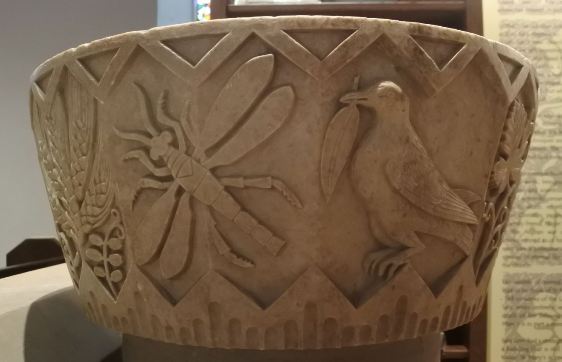
Having designed a number of works around the village in the 1820s, she turned to the creation of a church. Wreay’s medieval chapel had fallen into disrepair. Losh stepped in with money and lands for the church, so long as she could construct a new building according to her ideas, without interference. You don’t argue with the landowner, and so between 1840 and 1842, Losh got to build her church.
She used local craftsmen, notably stone mason William Hindson and family and her gardener Robert Donald. There is every indication that her ideas were taken up with enthusiasm by those around her. Creativity and free-thinking were encouraged and formulaic thinking rejected.
The result is a unique amalgam of faith, art, science and loss. Though it is a Christian church, it is remarkably sparing of direct Christian symbolism – there is no cross inside the church, for instance. Nor is there obvious Christian iconography: the remarkable 13-column colonnade behind the altar has twelve spaces for those seated at the Last Supper, but the painted names of the disciples are later additions. The man and woman whose heads are at the base of the arch could be Adam or Eve, or they could be anybody. Losh wanted to suggest rather than to instruct.

Moreover, there is much that points to a natural, or Deist, understanding of religion, one which find religious meaning in the natural world. It is there in Losh’s signature symbol, the pinecone – an ancient symbol of fertility, also a natural expression of geometrical complexity. Pinecones are on the arch over the door as you enter the church, they form the handles of the doors on the inside, they greet the visitor to either side as they first enter, they are on the roof beams, and one is be found in the idiosyncratic graveyard for Losh family and friends. There are animals everywhere – bats, serpents, owls, cockerels, the eagle and stork lecterns. The alabaster font – carved in part by Losh herself – has delightful animal and vegetable figures, with dragonflies and butterflies amid the plantlife.
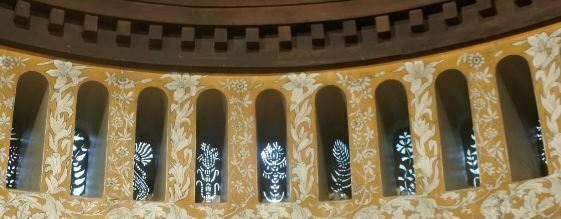
The mysteries of time and science are there in the fossil designs on windows high above the altar, copied from discoveries in the nearby Northumbrian shales. The peculiar pulpit was carved in the shape of a fossil tree out of a 3,000-year-old oak that was discovered in a nearby bog.
There are some more conventional Christian objects, including the prominent archangels either side of the chancel, and the row of angels high above the altar, interspersed with palm trees.

But St Mary’s Church feels as much a monument to personal feeling as anything else. Sarah Losh’s beloved sister, Katherine, with whom she travelled to Europe and shared her ideas, died in 1835. Outside the church is a dark mausoleum with a statue of Katherine inside, visible only through two small, grilled windows. The family graveyard with its wildly imaginative, rough-hewn gravestones is next door, including the shared gravestone of Katherine and Sarah, and a memorial (with pinecone, as noted) to family friend William Thain, killed in the disastrous British retreat from Kabul in 1842. The distinctive arrows on the church door may also be a tribute to Thain. St Mary’s is a private expression, a work of art in the shape of a church and its grounds, rather than a church building with works of art that may be integral but nevertheless play only a part in serving the overall conception.
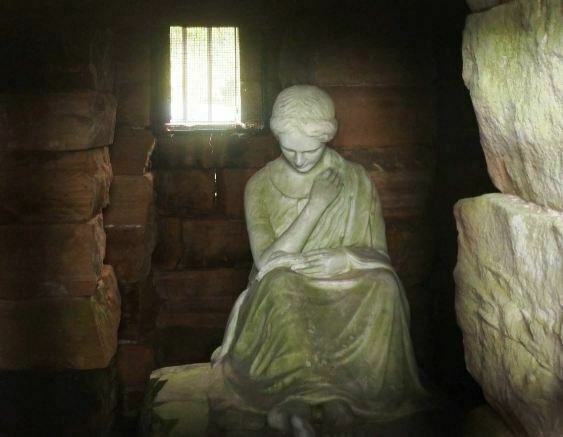
All of this might suggest a vain and indulgent creation. St Mary’s Church is anything but. One is struck by the restraint amid the originality. Losh never tries to do too much. Every element serves its purpose, in keeping with a natural history view of the ordering of things. Moreover, there is much that is simply fun. There are the exuberant gargoyles peeking from beneath the eaves of the roof, including a fearsome winged turtle, and a dragon out of whose mouth smoke used to issue when it was connected to a stove previously inside the church.
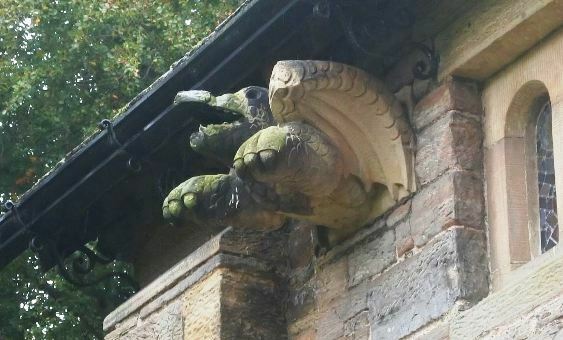
The fun is there in the stained glass, which has random pieces of glass from older windows incorporated into the fresh, abstract designs, creating a novel collage effect only apparent when one looks closely.
It is important to look closely. The longer one spend in the church the more the wit and ingenuity in its construction become apparent. Harmonies and counter-balances emerge, numerical and visual; messages are sensed if never quite pinned down; we are being told something, though its precise import is lost as Sarah Losh’s personal papers are lost. We may sense that it is as much an expression of a loss of faith as it is an affirmation of faith. It is a work of a changing Victorian mindset, first intimated in the work of the Romantic poets (Losh’s uncle James knew Coleridge and Wordsworth), that sensed the shadow of change that was to come with the publication of Darwin’s theories (in 1859, six years after Sarah Losh died). Religious belief might still be intense – Losh’s certainly was – but the guiding principle was becoming one of asking questions, as science demanded. It is a work both timeless and absolutely of its time, both private yet universal in its understanding.
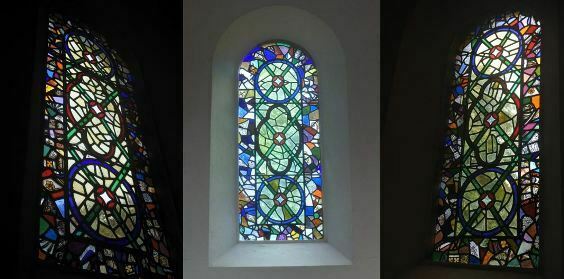
There is much in St Mary’s Church for the architectural historian to revel in – a work with so many influences that breaks so many rules yet is guilty of no architectural crimes. I know nothing of architecture beyond that which appeals immediately to this untrained eye. Expert knowledge helps understanding from an academic perspective, but it is not essential to an understanding of what the artist tried to do. It is the effect that matters, not the means – that shock to the system experienced when one first enters the church and witnesses harmony, absolutely realised. I am not entirely sure I know what it was that she set out to achieve. All that I do know is that she succeeded.
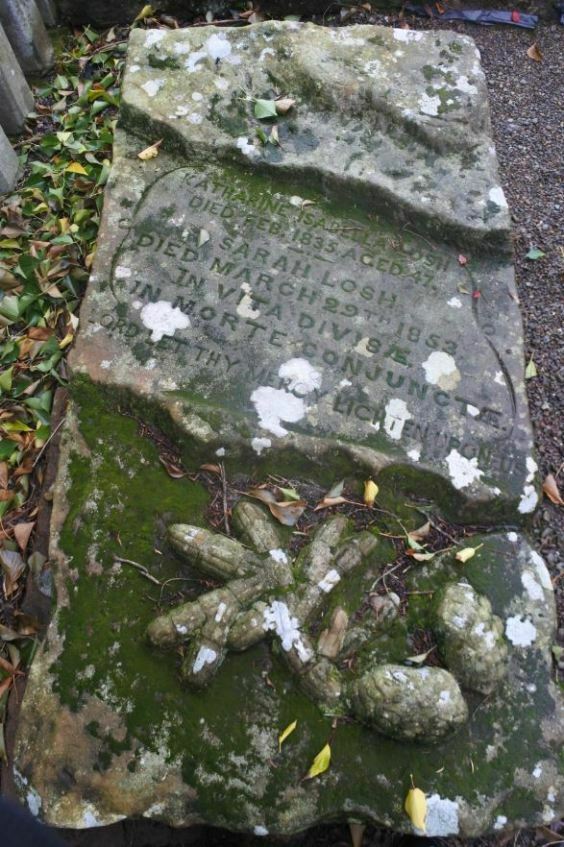
Links:
- There is a fine biography by Jenny Uglow with a title of which its subject would have approved, The Pinecone: The Story of Sarah Losh, forgotten Romantic heroine – antiquarian, architect and visionary
- If you visit Wreay, there are other buildings in the village, including its school, that Losh designed or otherwise influenced. In particular there is a former mortuary chapel, built first as a sort of dry-run for the church itself, which is now a heritage centre with plenty of information on Sarah Losh, her places and her times. St Mary’s Church continues as a church as well as a visitor attraction – there is more information on church, centre and walks in the areas at www.stmaryswreay.org
- There is an album photographs of Wreay and St Mary’s Church on my Flickr site
Amazing! what a story… and completely unknown to me. Part of the English tradition of the idiosyncratic (eccentric?), but clearly a fine work that stands outside traditions and schools. Many thanks for this inducement to go and see,
Definitely worth going to see, whatever the distance. It could be seen as part of that English tradition to produce follies, but it is so very much more. Jenny Uglow’s book explores the history and the motives very well.
Thank you, Luke, for a enlightening piece. Loved it. Must go myself to see it. The walk sounds great, too. A good way to prepare for the church.
Hi Marja,
Do go if you can. The walk from south Carlisle to Wreay isn’t great (too much walking along roads dodging traffic), but I then walked from Wreay east across country to Armathwaite (railway station on Carlisle-Settle line), which was excellent. Midway way, at Barrock Fell, you can see the Lake District hills to the far right and the Yorkshire Dales to the far left in one panoramaic sweep: https://www.flickr.com/photos/33718942@N07/48798467251/in/album-72157623237959660/
Luke